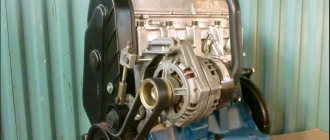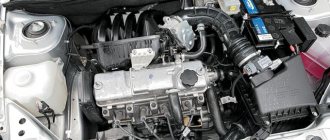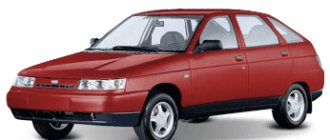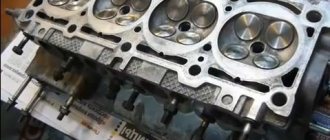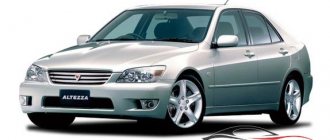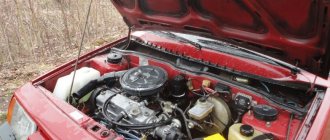JSC AvtoVAZ, in the process of producing cars of the tenth family, was constantly improving their power units. And engine 21124 is no exception.
Created on the basis of the 2112 engine in 2004, this engine differed favorably from other engines in this series due to its high environmental characteristics and increased cylinder capacity.
Later it became the prototype of more powerful VAZ power units:
- 21126, which has been installed on the VAZ 2170 Priora since 2007;
- 21128 with a volume of 1.8 liters, mass-produced at the Super-auto enterprise and intended for installation on LADA 112 Coupe, LADA Priora, etc.
Short description
The VAZ 21124 engine was installed on VAZ-2110, VAZ-2111 and VAZ-2112 cars. The engine is a continuation of the development of the VAZ-2112 engine. The main difference is the increase in engine capacity to 1.6 liters. This result was achieved by installing a crankshaft with an increased crank radius of 37.8 mm (for 2112 - 30.5 mm), while maintaining the cylinder diameter of 82 mm. The 21214 engine has a different cylinder block, with an increased height. A model 2112 damper is installed on the crankshaft. The main goal pursued by the designers was to increase environmental performance to meet the requirements of European standards.
Tuning
As a rule, the VAZ 21124 engine is subjected to chip tuning only after serious modifications associated with design changes. The easiest way to increase its power is as follows:
- Change the standard camshafts to “Stolnikov 8.9 2802” or “Nuzhdin 8.85”.
- Install a straight-through exhaust 4-2-1.
- Install the receiver and 55 mm damper.
- The piston group is replaced with a lightweight one (for example from Priora).
These simple changes will increase the power of the power unit to 120 horsepower.
- You can also improve the technical characteristics of the 21124 engine by installing a separate throttle valve for each cylinder. As a result, resonant air vibrations between the cylinders will disappear, and the power unit will operate more stably in all modes. The throttle intake system from the Toyota Levin is most suitable for this purpose.
In addition, taking into account the significant increase in engine speed, experts additionally recommend:
- change the piston group to a lighter one;
- install wide-phase camshafts, modifying the cylinder head for this purpose;
- install a direct-flow exhaust 4-2-1 on 51 pipes.
After such modifications and proper tuning, the engine will be able to develop power of more than 180 hp. With. In this case, the service life of the motor will significantly decrease, and the number of its breakdowns will increase sharply.
Engine characteristics VAZ 21124 1.6 16V
| Parameter | Meaning |
| Configuration | L |
| Number of cylinders | 4 |
| Volume, l | 1,599 |
| Cylinder diameter, mm | 82 |
| Piston stroke, mm | 75,6 |
| Compression ratio | 10,3 |
| Number of valves per cylinder | 4 (2-inlet; 2-outlet) |
| Gas distribution mechanism | DOHC |
| Cylinder operating order | 1-3-4-2 |
| Rated engine power / at engine speed | 65.5 kW-(89 hp) / 5000 rpm |
| Maximum torque/at engine speed | 131 N•m / 3700 rpm |
| Supply system | distributed injection with electronic control |
| Recommended minimum octane number of gasoline | 95 |
| Environmental standards | Euro 3, Euro 4 |
| Weight, kg | 121 |
Installation of a zero resistance filter
A zero-resistance filter, or simply “zero filter,” is mounted instead of the air filter and its housing. It is designed to reduce the resistance of incoming air into the system. Large filter throughput allows you to increase engine power by a couple of percent. Remember that the correct choice of filter and impregnation for it is the key to proper engine operation.
This tuning is one of the most affordable.
Channels and valves
- The exhaust and inlet channels are supposed to be ground , increasing the diameter at the inlet, and not changing the diameter at the outlet. We remove all irregularities and various joints that can in any way slow down the flow.
- Valves - it is better to use special lightweight or increased diameter ones. It is also expected to use the stiffest or sportiest springs, as well as lightweight valve plates.
The difference between the lightweight valve (left) and the regular one.
Cylinder block
The cylinder block of the 21124 engine (installed 11193-1002011) is made of high-strength cast iron.
| Parameter | Meaning |
| Material | Ductile iron |
| Cylinder diameter, mm | 82,0 |
| Intercylinder distance (distance between the axes of adjacent cylinders of the block), mm | 89,0 |
| Block height (distance between the upper plane of the block and the axis of the crankshaft), mm | 197,1 |
| Diameter of boring of crankshaft supports (for main bearings), mm | 54,52 |
| Weight, kg | 31,000 |
This block is distinguished by the presence of special nozzles pressed into the 2nd, 3rd, 4th and 5th main bearing supports. These nozzles are designed to cool the piston heads with oil while the engine is running.
Adsorber operation
I will try to briefly and clearly explain the principle of operation of the adsorber and purge valve. This unit is poorly described on the Internet and very often there are erroneous opinions on the principle of its operation.
The adsorber is primarily designed to reduce environmental pollution from gasoline vapors. Everyone knows that gasoline evaporates very well. So, on cars without an adsorber, gasoline evaporates into the atmosphere, and on cars with an adsorber, these vapors are burned in the engine cylinders.
The principle of operation of the adsorber on different cars is the same, the only difference is in the shape and location of the adsorber and the purge valve. For some, it is installed in the engine compartment, and, for example, for the Lacetti, it is installed under the bottom near the rear wheel, and the purge valve is in the engine compartment.
Fuel vapor from the tank enters the adsorber (a container with activated carbon) through a fitting marked “TANK”, where it accumulates while the engine is not running. The second canister fitting with the inscription “PURGE” is connected by a tube to the canister purge valve, and the third with the inscription “AIR” is connected to the atmosphere.
1 - AIR vent fitting, 2 - TANK fitting for the tube for supplying fuel vapors from the tank to the canister, 3 - PURGE fitting for the tube for removing fuel vapors from the adsorber to the valve
When the engine is stopped, the purge solenoid valve is closed, and in this case the adsorber does not communicate with the intake manifold.
When the engine is running, the electronic unit, controlling the solenoid valve, purges the adsorber with fresh air due to the vacuum in the intake manifold. That is, the vapors are sucked out of the adsorber.
Gasoline vapors are mixed with air and discharged into the intake manifold behind the throttle and then enter the engine cylinders.
Cylinder head
There are no significant differences from the cylinder head of the 2112 engine. The only thing is a large surface area for joining the intake pipe flanges. The intake and exhaust camshafts, valves, springs and hydraulic lifters remain from the 2112 model.
The Lada of the tenth family in the hatchback body is the VAZ-2112 model. All cars of this family were produced until 2009. The range of engines included four options. Among them, by the way, were two 8-valve engines. Below we present the characteristics of 16-valve engines, but engines with 8 valves do not deserve attention. The torque graph proves these words true. So, let's look at the characteristics of VAZ-2112 engines with four valves per cylinder.
Two different 16-valve valves accelerate the car differently. Here is a video of the test drive.
In arctic conditions, a simple crane from model 2108 is more reliable.
In arctic conditions, a simple crane from model 2108 is more reliable.
In arctic conditions, a simple crane from model 2108 is more reliable.
For many people, shock absorbers work, as they say, until the bitter end - until they completely leak. Of course, you shouldn't wait for this. Body sway and loss of trajectory stability already by 60,000 km (a very worthy resource!) became quite noticeable, and we replaced the shock absorbers. Instead, they supplied SS20 products from System of Technologies. These, working to this day, do not knock, do not leak, and with them the car holds the road well.
The battery, after serving for three years, stopped accepting a charge. The reason is simple: the charging voltage is low - about 13.9 V, and even less when the headlights are on. The battery, remaining undercharged, quickly sulfates, and it is not always possible to “boost” it to its nominal capacity. Therefore, having bought a new one, we built a diode into the voltage regulator circuit, raising the voltage to 14.5 V. Since then, the battery has served faithfully.
Once, while traveling in the winter Arctic, the climate control failed - the heater damper drive burned out. There are no spare parts, and in the cold you can’t do much without a stove. We had to look for a solution. First of all, we forcibly opened and locked the damper. Heat entered the cabin, and its excess was dumped out the open window. The next day, the mechanics of an unknown service station cut a tap from a G8 into the heater hose, and its drive—a choke cable from a Lada—was brought into the cabin under the steering column.
Graphs of 16 valve engines - power and torque
All engines of the “tenth hatchbacks” are ordered by power as follows: 21120, 21124, 21114 and 2111. They develop 93, 90, 81 and 77 “forces”. The graph shows how power varies with rpm.
The first two engines, 20 and 124, are 16-valve. Both belong to the Euro-3 class.
Engines 21124 of later years of production meet Euro-4 standards. They have an improved catalyst installed. The ECU unit was also installed differently, updated.
124 engine under the hood of the “two-wheeler”
The pistons of the 124 series engines have grooves for the valves. Simply put, the internal combustion engine of the VAZ-21120 is plug-in (valve bending as a result of a broken timing belt, the valves will need to be replaced, and then it depends), and 21124 is not plug-in (does not bend the valve). Let's estimate the torque.
The most interesting thing here is the VAZ-21120 engine. In terms of “low-end traction” it is not much inferior to 8-valve engines.
Formal characteristics
Here are the characteristics of two different motors:
- ICE model: 21120/21124;
- Working volume: 1,488/1,596 l;
- Compression ratio: 10.5/10.3;
- Power: 93/90 hp;
- Rated power speed: 5600/5000 rpm;
- Maximum torque: 140/131 N*m;
- Recommended fuel: AI-95/AI-95;
- Ecology: Euro-3/Euro-4 or Euro-3.
The lower the compression ratio, the more “omnivorous” the engine will be in relation to fuel.
Heater radiator - change! The steam outlet fitting is broken.
Heater radiator - change!
The steam outlet fitting is broken. Heater radiator - change! The steam outlet fitting is broken.
By the end of the reporting period, the trunk floor presented a problem: its plastic base crumbled into fragments, the carpet turned into a shapeless rag. Based on the prints on the rug, we cut out 5 mm thick hardboard panels and glued them to the upholstery with “liquid nails” - it turned out they didn’t hold! I had to put him on wire braces. The decision was completely justified.
Each kilometer of our “two-wheeler” cost 2.23 rubles. We think it’s acceptable, and in general we’re happy with the car. Although, of course, it’s a pity that the energy and time wasted on numerous repairs.
Final table (click to open full size):
Some conclusions
The steel receiver looks powerful and beautiful
All VAZ-2112 hatchback engines differ in characteristics, and the differences are significant. It seems that the best option would be a 16-valve 1.5-liter engine. But the 21124 (1.6) engine has its advantages:
- Rated power is achieved at 5000 rpm rather than 5600;
- A broken timing belt does not lead to bending of the valves and their replacement;
- It is acceptable to use 92nd gasoline.
Any 21124 engine can be converted to Euro-4 or meets these standards immediately.
The appearance of the 1.5 liter engine inspires respect. But if you remember about bending the valves, the choice becomes difficult to make. A steel receiver and a beautiful schedule are not everything.
Various nuances
Motor 21124 is more modern than its brother. It has spark plugs with individual coils installed on it. Experienced craftsmen also know about the tuning possibilities specific to the 21120 engine (for example, installing a turbine). In defense of the latter, we can say the following: the service life of the two engines under consideration is approximately the same. After the first 120 thousand, the 20th engine deserves a rating of “4.5 out of 5”.
On the secondary market, VAZ-21120 and 21126 (Priora) engines are valued almost equally. But the VAZ-21124 unit is in short supply. Draw conclusions.
An exhaust manifold
This system is designed to improve the release of exhaust gases. People call this system “spider”, and there can be mainly two options: “4-1”, “4-2-1”.
Three types of collectors
It is advisable to install the exhaust system after working with the gas distribution mechanism, pistons, “nulevik” or chip tuning. Single-purpose installation of this system will not bring the desired results.
VAZ 16-valve engines: video comparison
- Engines
- VAZ
- 21124
The 1.6-liter 16-valve engine of the VAZ 21124 was produced by the concern from 2004 to 2013 and was first installed on models of the tenth family, and then for some time on the Samara 2. This engine was replaced on the assembly line by a 1.5-liter 16-valve power unit with the index 2112.
The VAZ 16V line also includes: 11194, 21126, 21127, 21129, 21128 and 21179.
- Characteristics
- Description
- Consumption
- Application
- Reviews
- Service
- Breakdowns
- Prices
Malfunctions
VAZ 21124 engines have the same set of characteristic disadvantages characteristic of all VAZ engines. The most common:
| FAULTS | CAUSES | REMEDY METHODS |
| The engine is unstable or stalls at idle. | Ÿ Broken idle speed sensor. Air leaks through the crankcase ventilation hoses and the hose connecting the intake manifold and the vacuum brake booster. | Ÿ Change the idle speed sensor; replace damaged hoses; Ÿ tighten the hose clamps. If this does not help, check the serviceability of the fuel injection system. |
| The motor does not develop full power. | Ÿ The throttle valve does not open fully. Ÿ Broken throttle sensor. Ÿ The air filter is clogged. Poor quality fuel. | Ÿ Adjust the throttle valve drive; Ÿ change the faulty sensor; Ÿ change the air filter. |
| Increased fuel consumption. | Ÿ Ÿ Fuel leaks in connections. Ÿ Broken injectors and/or ignition system. Increased resistance to vehicle movement. | Ÿ Fill with high-quality fuel; Ÿ check and, if necessary, tighten the fastening clamps. Replace damaged parts; check the operation of the engine control system and fuel injection; Ÿ check the alignment of the front wheels, the operation of the brake system and the tire pressure. |
Technical characteristics of the VAZ 21124 1.6 16v engine
| Type | in-line |
| Number of cylinders | 4 |
| Number of valves | 16 |
| Exact volume | 1599 cm³ |
| Cylinder diameter | 82 mm |
| Piston stroke | 75.6 mm |
| Supply system | injector |
| Power | 89 hp |
| Torque | 131 - 133 Nm |
| Compression ratio | 10.3 |
| Fuel type | AI-92 |
| Environmental standards | EURO 2/3 |
Maintainability
All car enthusiasts note the high maintainability of the engine. Indeed, a cast-iron cylinder block allows cylinders to be bored repeatedly, which means that major overhauls of the internal combustion engine can be done several times.
There are no problems in selecting spare parts for restoration. They are available in any variety in every specialty store. The only trouble that an inexperienced car owner can run into is experiencing the possibility of purchasing counterfeit products. The Chinese manufacturer is considered especially “dangerous” in the supply of such spare parts.
The interchangeability of parts, assemblies and mechanisms from other engines in the VAZ 16V line is of great help to the car owner when repairing the unit.
The repair itself is simple and accessible to anyone who has little experience in performing such work. Many car enthusiasts take advantage of this and restore engines in garage conditions.
By the way, car services are also happy to take on this work due to its simplicity.
In the most extreme case, the engine can be replaced with a contract one, but difficulties may arise with its acquisition, or rather, with its search. The fact is that the VAZ-21124 internal combustion engine is included in the category of scarce ones on the secondary market.
Conclusion: unit repair is available not only to professionals, but also to amateurs.
Design features of the Lada 21124 16 valve engine
First of all, the internal combustion engine differs from the previous 1.5‑liter VAZ 2112 in a higher block. And an increase in the piston stroke by 4.6 mm made it possible to increase the engine displacement to 1.6 liters. Thanks to the holes in the piston bottoms, this power unit does not bend if the valve belt breaks.
This motor has received a number of modern design solutions. In addition to the previously used hydraulic compensators, it was the first to use individual ignition coils. And the catalytic collector allowed it to comply with strict environmental standards of EURO 3 (later EURO 4).
Popular blogger Evgeny Travnikov compares the characteristics of the 24th and 26th internal combustion engines.
The magazine Behind the Wheel wrote about the new AvtoVAZ engines 21114 and 21124
Reliability
The reliability of the VAZ-21124 internal combustion engine is indicated by the fact that it exceeds the mileage life established by the manufacturer. There are engines that have gone through more than 300 thousand km without major repairs. This is clearly visible from the communications of forum members. Thus, Maxim writes: “... an engine with a long service life. Mileage 330 thousand. Doesn't take oil. Replace the timing belt according to the regulations, every 45-50 thousand km, pump every 100 thousand. The oil was 5-40 synthetic.”
The manufacturer constantly makes changes to the design of the motor in order to increase its reliability. There has been a decrease in electrical failures (due to the abandonment of high-voltage wires, the installation of individual coils and other innovations).
Reviews of engine 21124 its pros and cons
This power unit at one time replaced the 1.5-liter VAZ 2112 engine and, in theory, should have become more powerful than its predecessor, but in reality it turned out to be even a little weaker due to the catalytic converter. The owners were upset that with the transition to a larger volume, the power did not increase.
Great progress was the emergence of individual coils; there were much fewer failures in the ignition system. In all other respects, this is a typical VAZ engine of its time.
Fuel supply
Conventional injectors are not enough to operate the engine at high speeds. Since they are constantly in operation, the working pressure in the ramp is simply not enough. In order to increase engine power, you should install the most efficient nozzles, which can increase the volume of sprayed liquid several times. Such changes work most effectively with the 4-2-1 release technology.
Turbocharging
- The most effective, widespread and most expensive type of tuning is the installation of a turbine. After all, it is known that in order to increase engine power, it is necessary to supply the largest amount of a mixture of air and fuel into the cylinders.
- However, to increase the volume of fuel, a mandatory increase in the amount of air will be required, which is what the turbine does. The exhaust gases enter the turbine impeller, then it rotates and drives the compressor, which in turn pumps air into the cylinders.
- Since the air is pumped under pressure, its quantity increases significantly, which leads to an increase in fuel combustion, which results in an increase in power.
- Remember that installing a turbine will lead to a mandatory upgrade of the cooling system (diagram of a standard cooling system here).
The most expensive method of tuning a VAZ-2112.
Maintenance regulations for internal combustion engine VAZ 21124
The service book recommends that you undergo zero maintenance at a mileage of 2,500 km and then service the engine every 15,000 km, but on the forums they advise reducing this interval to 10,000 km.
To replace, you will need from 3.0 to 3.5 liters of 5W-30/5W-40 oil, as well as a new filter. It is advisable to change the spark plugs and air filter every 30,000 km, and the timing belt every 45,000 km. Adjustment of the thermal clearances of the valves is not required; the unit is equipped with hydraulic compensators.
Cleaning the nozzle without removing it
In this case, cleaning can be carried out using several methods:
- Using special cleaning additives that are added to the fuel. They contain special cleaning agents that gently clean the injector openings.
- Cleaning using pressure. To do this, you need to accelerate the car to a speed of 110.130 km/h, and drive for 10.15 km (about 5.6 minutes) at high engine speeds. Due to the high load, natural cleaning will occur in the nozzles.
- Idling. This method is similar to the previous one. It is necessary to start the engine while the car is stationary and maintain the speed at 4.5 thousand for 3.4 minutes. This will also clean the injectors. However, the previous cleaning method is better because the load under its conditions is higher.
conclusions
Problems with the operation of the injectors are not a critical failure, but if they occur, we recommend that you do not delay checking and eliminating the malfunction. In most cases, repair work can be carried out independently using the methods described above. Timely checking and diagnostics of injectors will allow you to avoid problems with the operation of the machine. Prevention will cost you less than repair work on injectors or other engine components. We recommend that you clean the injectors every 30.35 thousand kilometers of your car, regardless of their condition.
A faulty injector (nozzle) has a negative impact on the operation of the vehicle engine. The sooner the car owner finds out the cause of the malfunction, the sooner he will eliminate it, saving a significant amount of time, nerves and money. Listed below are signs of an injector malfunction that indicate the need for repair and maintenance work.
Common problems of internal combustion engine 21124
The idle speed most often fluctuates due to a dirty throttle. Another reason can be glitches of the mass air flow sensor, crankshaft and throttle position sensors, as well as IAC.
The culprits of engine trouble are usually clogged injectors, faulty ignition coils or spark plugs. This happens a little less often due to burnout of the valves.
Various types of noise from under the hood are usually caused by worn hydraulic compensators or a stretched timing belt. However, this may also very well be a sign of critical wear of the ShPG. In this case, professional diagnosis is required.
Northern version of heater control. View from the salon.
Northern version of heater control.
View from the salon. Northern version of heater control. View from the salon.
The solution turned out to be so simple and successful that later the damper control was restored in the same way. Not electronics, of course, but trouble-free and even duplicated - you can control the tap, or you can control the damper! And we don’t even remember the imaginary loss of comfort - the controls are supposedly now manual.
The latest improvements include small side headlights to shine on the roadside when turning. They turn on automatically when you turn the steering wheel. An extremely convenient thing when maneuvering in the dark! And the last major expense was replacing the driver’s seat for 3,500 rubles. The old one had sat down to the frame, the foam rubber had decayed - and no amount of plywood could return it to its original shape.
Of course, we constantly monitored tires, brakes, etc. Consumables, of course, cost money, but safety is more expensive. However, operation did not cost 5–6 rubles per kilometer, but three times cheaper.
Final table (click to open full size):
